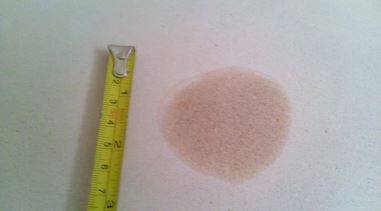The DIY Fix is reader supported. When you buy after clicking a link on our site, we may earn an affiliate commission.
 For each of the three main types of damp that can occur in a property: condensation damp, penetrating damp and rising damp, damp patches on internal walls is a common symptom. The steps you need to take to stop damp patches from appearing again on the internal walls are quite varied. Treatment will depend on the type of damp that is affecting the property and the extent of the damage.
For each of the three main types of damp that can occur in a property: condensation damp, penetrating damp and rising damp, damp patches on internal walls is a common symptom. The steps you need to take to stop damp patches from appearing again on the internal walls are quite varied. Treatment will depend on the type of damp that is affecting the property and the extent of the damage.
One thing worth remembering is that the earlier you spot damp and treat it, the better, cheaper (usually) and easier the process will be. And with damp patches, they are often not noticeable straight away. Over time, dark patches will emerge and often black mould spots will form around them too. However, this does not occur instantly.
So, in areas of the house that you think might be more susceptible to damp (such as the inner walls adjacent to the exterior of the property) and also in older buildings, it’s a good idea to place the back of your hand onto the wall to check if there are any signs of damp. If it does feel damp, a damp moisture meter can then be used to ascertain the extent of the problem.
Condensation Damp Patches on Internal Walls
If the damp patches on internal walls are a result of condensation, the problem is often fairly simple to remedy. If a property is poorly ventilated or has an excess of moisture present it can cause damp patches and mould to form on the inner walls. This is when warm moist air comes into contact with a much cooler surface, such as an internal wall. It cools quickly and condenses into water. As this sits on the surface of the wall, damp patches are formed. In the best case scenario, just taking steps to improve ventilation will often do the trick. If the damp patches are slight, a lick of damp proof paint is a good idea to offer protection for the future.
Penetrating Damp Patches on Internal Walls
This type of damp is usually caused by building defects. Sometimes relatively minor, occasionally quite serious, but one of the common symptoms is the same – damp patches on internal walls. For example, if you have located a section of wall which is affected by a damp patch, these could be being caused by cracks in the mortar of the external wall. The cracks could be allowing draughts into the cavity, cooling the internal wall and preventing it from warming up like the rest of room does.
Other common defects that cause water to penetrate from the exterior to the interior are broken or missed roof tiles, flashing defects and cracked guttering. All of these issues will cause water ingress which will ultimately lead to damp patches on internal walls.
Whether the defect itself is big or small, a major repair job or a simple DIY task – the principle is always the same. To stop damp patches getting worse and to prevent them from occurring again, the defect itself has to be fixed.
Rising Damp Patches on Internal Walls
Rising damp is also characterised by damp patches on internal walls. As with all types of damp, the cause has be dealt with before you repair the damage of damp patches. With rising damp, the treatment which is usually required is a new damp proof course. It is caused, in most cases, because there is no DPC in the property or because the existing DPC has failed. Water rises naturally but without the barrier of a damp proof course it will continue to rise and come through onto the internal walls. This is how damp patches occur.
In conclusion, damp patches on internal walls are normally treated by improving ventilation and reducing the amount of moisture in a property; repairing structural or building defects or inserting a new damp proof course. Once one or more of those issues has been addressed, the damp patches should not reoccur.

